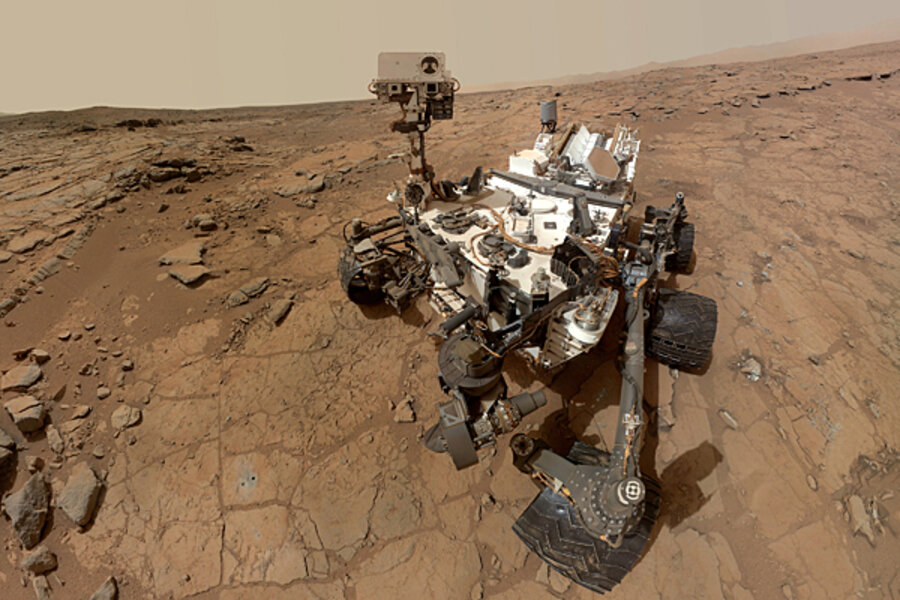Latest Curiosity feat: confirmation that Mars sent meteorite group to Earth
Loading...
Mars has lost from half to 95 percent of its atmosphere over the past 4 billion years, a loss that turned a once-warm, wet surface into hostile environment for life, according to a new study.
Scientists base the estimate on measurements from the National Aeronautics and Space Administration's Mars rover Curiosity. The measurements are the most precise readings yet of two forms of the element argon. Argon doesn't react chemically with other elements. This makes it a relatively reliable indicator for changes in the atmosphere's thickness and composition over time, the researchers say.
With the exception of similar measurements taken by NASA's Viking landers, which operated from the surface of Mars from 1976 to 1982, scientists have had to rely on samples of Mars' atmosphere captured in Martian meteorites to make similar argon measurements. But those measurements could provide only a range.
The precise measurements that Curiosity has made fall squarely within the range and closely match the meteorite measurements – in the process, confirming that the meteorites are genuine pieces of Mars, according to the team reporting the results.
The origin of some Martian meteorites has been well established. But for a relatively new class, the evidence has been less clear. The measurements that the team made at Mars match the argon abundances in this class group.
“We really nailed it,” said Sushil Atreya, director of the Planetary Science Laboratory at the University of Michigan in Ann Arbor and the lead author of the study, in a prepared statement.
"This is the first time we're getting these two isotopes from the atmosphere on Mars," adds Melissa Trainer, a researcher at NASA's Goddard Space Flight Center in Greenbelt, Md., and a member of the team conducting the study.
The results are set to appear in an upcoming issue of the journal Geophysical Research Letters.
The isotopes, or forms, of argon in question are argon-36 and its heavier sibling argon-38. Similar argon measurements have been made for the sun and Jupiter. The composition of the sun and Jupiter is thought to most closely reflect the chemical makeup of the vast cloud of dust and gas that gave rise to the sun and planets some 4.6 billion years ago, Dr. Trainer explains.
Measurements point to a ratio of 5.5 argon-36 atoms for each argon-38 atom as the primordial abundance. Viking delivered a range of 3.6 to 4.5 for Mars. Curiosity's measurements point to a ratio of 4.2 argon-36 atoms to each argon-38 atom.
The measurements were taken with Curiosity's Sample Analysis at Mars (SAM) laboratory, tucked inside the rover's chassis. SAM analyzes samples of the atmosphere as well as rock samples that the rover's arm delivers.
The difference between the primordial abundances and those on Mars today seems small. But they speak to big changes, the researchers say.
Argon is heavier than other gases in the atmosphere – hydrogen, nitrogen, and oxygen, for instance. If a range of processes in the atmosphere are energetic enough to strip it of some of its argon, no doubt they can do a more thorough job on the lighter elements.
Indeed, results from SAM presented in July in the journal Science found that Mars' atmosphere has enriched levels of carbon-13 compared with lighter variants. That also testifies to significant atmospheric losses, the researchers noted at the time. Isotopes of hydrogen, nitrogen, and oxygen tell similar tales.
The SAM results published in July also included measurements of the relative abundance of argon-40 to argon-36. This measurement foreshadowed these newest results. But argon-40 comes from the radioactive decay of potassium-40; its abundance can vary over time in ways that make it less reliable than argon-38 as an indicator of the atmosphere's demise, Trainer says.
Several processes could have conspired to strip Mars of its atmosphere, Dr. Atreya explains in an e-mail. High temperatures in the upper atmosphere could have stripped the lighter forms of hydrogen. Isotopes of heavier elements could have been lost through collisions with charged particles streaming from the sun as solar wind. Mars gradually lost its planetary magnetic field, which would have deflected most of those incoming particles.
"Much more work is needed before we can sort out the various mechanisms," Atreya says, "but data on escape rates from MAVEN high up in the atmosphere would provide additional information that we can use, along with the data obtained by Curiosity on the surface."
NASA is slated to launch MAVEN (Mars Atmosphere and Volatile Evolution spacecraft), an orbiter designed to help uncover the history of the Martian atmosphere, on Nov. 18.







